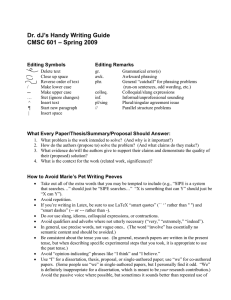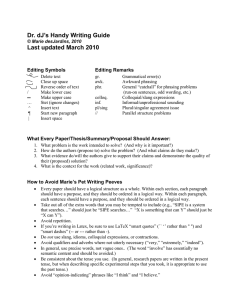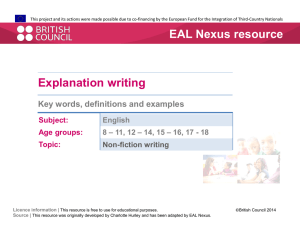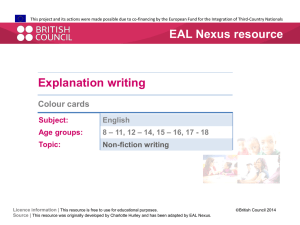r. dJ’s Handy Writing Guide D – Spring 2013 CMSC 304
advertisement
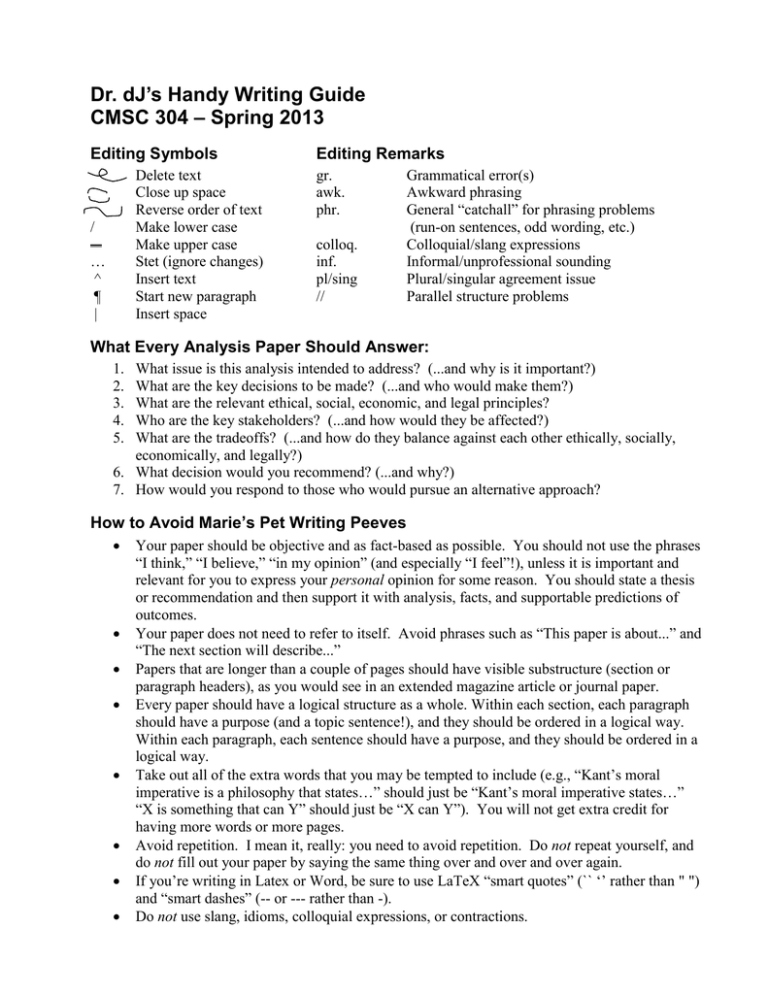
Dr. dJ’s Handy Writing Guide CMSC 304 – Spring 2013 Editing Symbols Delete text Close up space Reverse order of text Make lower case Make upper case Stet (ignore changes) Insert text Start new paragraph Insert space / … ^ ¶ | Editing Remarks gr. awk. phr. colloq. inf. pl/sing // Grammatical error(s) Awkward phrasing General “catchall” for phrasing problems (run-on sentences, odd wording, etc.) Colloquial/slang expressions Informal/unprofessional sounding Plural/singular agreement issue Parallel structure problems What Every Analysis Paper Should Answer: 1. 2. 3. 4. 5. What issue is this analysis intended to address? (...and why is it important?) What are the key decisions to be made? (...and who would make them?) What are the relevant ethical, social, economic, and legal principles? Who are the key stakeholders? (...and how would they be affected?) What are the tradeoffs? (...and how do they balance against each other ethically, socially, economically, and legally?) 6. What decision would you recommend? (...and why?) 7. How would you respond to those who would pursue an alternative approach? How to Avoid Marie’s Pet Writing Peeves Your paper should be objective and as fact-based as possible. You should not use the phrases “I think,” “I believe,” “in my opinion” (and especially “I feel”!), unless it is important and relevant for you to express your personal opinion for some reason. You should state a thesis or recommendation and then support it with analysis, facts, and supportable predictions of outcomes. Your paper does not need to refer to itself. Avoid phrases such as “This paper is about...” and “The next section will describe...” Papers that are longer than a couple of pages should have visible substructure (section or paragraph headers), as you would see in an extended magazine article or journal paper. Every paper should have a logical structure as a whole. Within each section, each paragraph should have a purpose (and a topic sentence!), and they should be ordered in a logical way. Within each paragraph, each sentence should have a purpose, and they should be ordered in a logical way. Take out all of the extra words that you may be tempted to include (e.g., “Kant’s moral imperative is a philosophy that states…” should just be “Kant’s moral imperative states…” “X is something that can Y” should just be “X can Y”). You will not get extra credit for having more words or more pages. Avoid repetition. I mean it, really: you need to avoid repetition. Do not repeat yourself, and do not fill out your paper by saying the same thing over and over and over again. If you’re writing in Latex or Word, be sure to use LaTeX “smart quotes” (`` ‘’ rather than " ") and “smart dashes” (-- or --- rather than -). Do not use slang, idioms, colloquial expressions, or contractions. Avoid qualifiers and adverbs where not utterly necessary (“very,” “extremely,” “indeed”). In general, use precise words, not vague ones. (The word “involve” has essentially no semantic content and should be avoided.) Be consistent about the tense you use. (In general, analysis and research papers are written in the present tense, but when describing specific events that occurred in the past, it is appropriate to use the past tense.) Do not use “we” unless you are actually referring to yourself and one or more other people. Especially avoid the generic or editorial “we” (“We can see that...,” “We know that...”). Avoid the passive voice where possible, but sometimes it sounds better than repeated use of “I” or “we.” Never use a citation as a noun: “Smith (1995) says…” – not “(Smith 1995) says” or, worse yet, “[19] says.” Hyphenate compound adjectives (“the blue-sky idea”), not nouns (“the blue sky was cloudless”) or adverbs (“the well tempered clavier”). Use commas generously to separate prepositional phrases and subclauses, and to clarify parsing. Don’t be skimpy with the commas – they don’t cost that much to print out. Punctuation goes inside quotes. (“Like this.”) Use “scare quotes” or italics to introduce new terms (but only the first time). Avoid excessive or random capitalization of terms. Always put a comma after “e.g.” and “i.e.,” include the necessary periods to indicate that they are abbreviations, and use these phrases sparingly. (Please do not italicize them; it looks pretentious and is unnecessary.) Also note that “et al.” is short for “et alia,” so “et” does not have a period after it, but “al.” does. Absolutely, positively, never use “such as” and “etc.” in the same phrase. Note also that “like” means “similar to,” whereas “such as” introduces a list of examples. Parallel phrases and bulleted items should have the same grammatical form. Avoid the use of “he” as a generic personal pronoun. Rewrite to avoid personal pronouns, or use “they” in the singular (which is now commonly accepted practice). Provide complete bibliographic information for all references listed in the bibliography. Plural acronyms and the like do not require an apostrophe (“ATMs,” not “ATM’s”). In lists of three or more items, include a comma before the “and” – grammatically this is optional, but much easier to parse. In general, numbers up to ten should be spelled out, (“one,” not “1”) and larger numbers should not. (This rule doesn’t apply to numeric results of mathematical equations, only numbers of things in prose.) Sentences should not start with numbers, variables, or function names. Specific pet peeves to avoid: “Its” means “belong to it”; “it’s” means “it is.” “Which” qualifies (and is always preceded by a comma); “that” defines. Heuristic: use “that” unless it sounds wrong. “Between” is used for two objects; “among” is used for three or more. “This” should not be used as a standalone noun. (“This approach is more effective…,” not “This is more effective…”) “Effect” is usually a noun; “affect” is usually a verb. (But you “effect” (cause) change; you rarely “affect” (influence) change.) “As” should usually be replaced with “because” or “since.” “Via” should usually be replaced with “using” or “by.”
